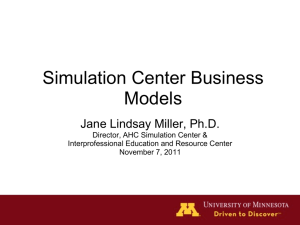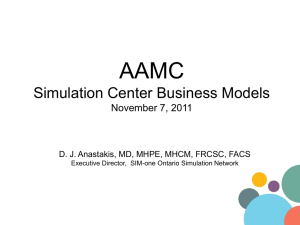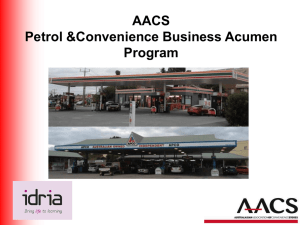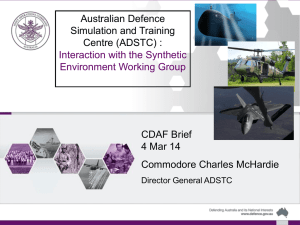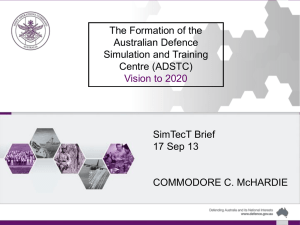Max Britton - "Simulation as a Service"
advertisement
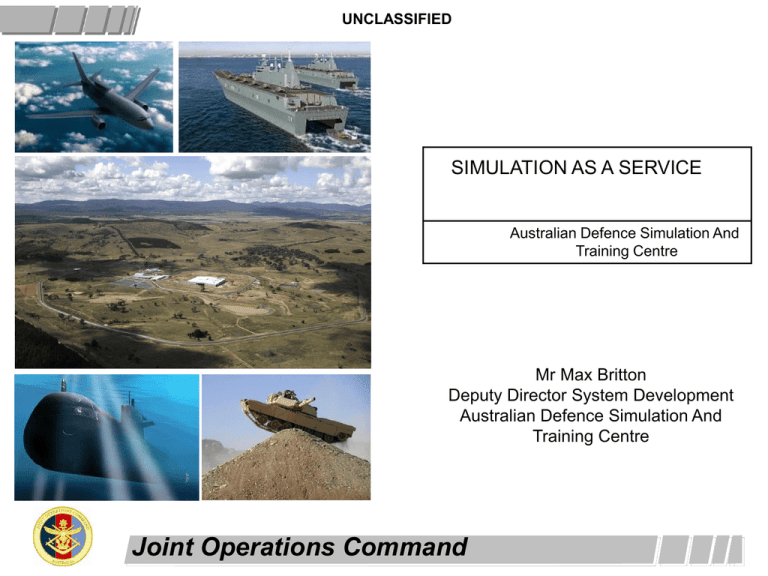
UNCLASSIFIED SIMULATION AS A SERVICE Australian Defence Simulation And Training Centre Mr Max Britton Deputy Director System Development Australian Defence Simulation And Training Centre Joint Operations Command Think about the following • • • • • Persistent Repeatable Agile And, Defendable Joint Operations Command The Journey • In 1964 the RAN had a distributed multi ship training system called ARGIS • This was an electronic analogue system • Trained Command Teams and Warfare officers in the multi ship and single ship environment • Based on DDG, DE and Aircraft Carrier Opps rooms (HMAS Melbourne) Joint Operations Command The Journey Continued • This was the start of the simulation training path within the distributed world • Provided a common and consistent training outcome that was measureable and repeatable • Allowed Command teams to train as they fought • Enabled tactics and doctrine to be explored Joint Operations Command The Dark Ages • Ship Platforms changed and the training system did not replicate the new capabilities • FFG class Ship introduced in the early 1980’s so new training system required • Ongoing need to train DDG class Command Teams Joint Operations Command The Next Generation • The IOTTF (Integrated Operation Team Trainer) developed to support FFG and DDG CTT in the early 1990’s • Again distributed within it’s own propriety environment • This is about the time I started to take an interest in the simulation world • Add to the complication ANZAC class FFH Joint Operations Command Next Generation Continued • ANZAC class CTT training system deployed at HMAS Watson in 1994 • No distributed environment or gateway • No ability to train in a 3 ship collective environment • No common data sets or models • Training outcomes challenging Joint Operations Command Distributed Training seen as a priority again • Project SEA 1412 stood up to provide a multi ship CTT training environment • Used DIS as the enabler for interaction between IOTTF and ANZAC CSTT simulators • Included Digital accrual voice system and simulated TDL • Back to the 60’s and 70’s capabilities Joint Operations Command Coalition Interoperability • CREAMS program stood up between USN and RAN in early 2000 • Coalition Fleet training established using distributed systems • Used ISDN lines and covered data using early bulk encryption units • Add hock development • Designed as event based Training Joint Operations Command The Problem Space • • • • • Data sets different between Simulators Geospatial data inconsistent Models not consistent Interoperability compromised Training value diminished without human intervention • Fair Fight principles less certian Joint Operations Command Other ADF Capabilities • Army have significant simulation assets • Tools such as JSAF, ONESAF • User of VBS, Steel Beasts and vehicle trainers • Mature distributed LVC environment • BSC’s situated at major bases • Exercises designed as event based activities Joint Operations Command Other ADF Capabilities • Air force has significant flight simulation trainers • Full mission and part task training systems • Air Control simulations • Less use of distributed simulation • Generally user to train individuals and not teams Joint Operations Command Other ADF capabilities • DSTO is a significant user of distributed simulation for experimentation • LVC tools used as part of normal business • Numerous battle labs • JDSC in Canberra • Heavy support to ADF in the training world • Highly skilled workforce Joint Operations Command The joint world • ADSTC formed taking ADSO , JCTC and J7 groups to form the one organisation • Heavy user of distributed simulation • Major role is to support Joint training outcomes • Coalition training • Supports single service exercises • Highly skilled workforce Joint Operations Command The problem space • • • • • • • • Data not reused Data sets not common and consistent Geospatial terrain not always available Often not in the correct format Expensive assets not fully exploited Add hock development of simulation Full of stove pipe solutions Inconsistent use of standards Joint Operations Command The problem space continued • Limited distributed access to data • Buying or re building the same data time and time again • Not using or exploiting the available resources • Reduced training outcomes • Taxpayer not getting best value for money Joint Operations Command What do we do to fix the problem? • Architecturally design the Simulation environment • Defence Simulation Architecture being developed as part of the Defence Enterprise Architecture • Standards based solution • Enterprise level coordination of resources • Reuse of data Joint Operations Command Fixing the problem continued • • • • Engagement of the stakeholder Knowledge management Data catalogues and repositories Common and consistent objects and entities • Seamless distributed networks • Enterprise level licenced applications that are in the distributed environment Joint Operations Command Fixing the problem continued • Up skilling our people through distributed e-learning • Coordinated reuse of data • Translation services Joint Operations Command Getting to where we need to be • • • • Simulation should be a seamless service JP 3035 will provide the glue ADSTC will coordinate the resources DSA will continue to evolve over time to refine and gap analyse the capability Joint Operations Command Simulation as a service should be • • • • • • Persistent Repeatable Agile seamless And, Defendable Joint Operations Command Questions? Joint Operations Command



